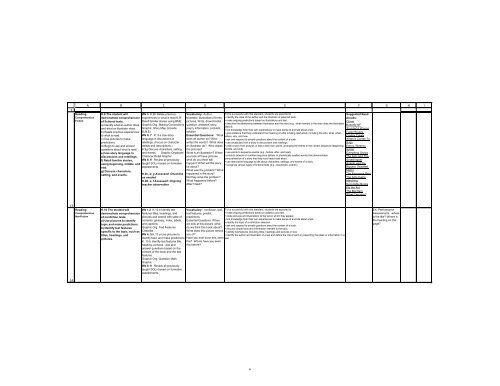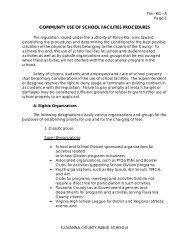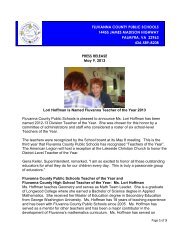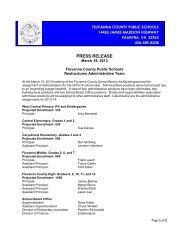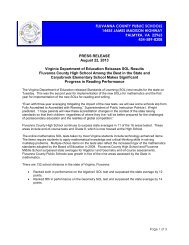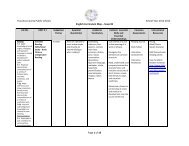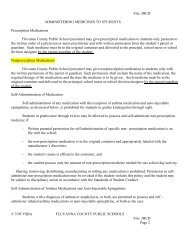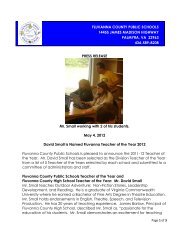K Curriculum Map 2013-14 - Fluvanna County Public Schools
K Curriculum Map 2013-14 - Fluvanna County Public Schools
K Curriculum Map 2013-14 - Fluvanna County Public Schools
Create successful ePaper yourself
Turn your PDF publications into a flip-book with our unique Google optimized e-Paper software.
A B C D E F G H I<br />
3<br />
Reading<br />
K.9 The student will<br />
Wk 3 K.9b Relate previous Vocabulary: Author, To be successful with this standard, students are expected to<br />
Suggested Read<br />
Comprehension demonstrate comprehension experiences to what is read.K.9f Illustrator, illustrations,Words, • identify the roles of the author and the illustrator of selected texts.<br />
Alouds:<br />
Fiction<br />
of fictional texts.<br />
Retell familiar stories using BME. pictures, Write, draw,Predict, • make ongoing predictions based on illustrations and text.<br />
Closer<br />
• describe the relationship between illustration and the story (e.g., what moment in the story does the illustration<br />
a) Identify what an author does Graphic Org: Making Connections question, answere, story,<br />
Butterfly-NF<br />
depict).<br />
and what an illustrator does. Graphic, Story <strong>Map</strong> (Include poem, information, problem,<br />
Wonderful Worms<br />
• link knowledge from their own experiences to make sense of and talk about a text.<br />
b) Relate previous experiences B,M,E)<br />
solution<br />
Fuzzy Wuzzy,<br />
• give evidence that they understand the meaning of what is being read aloud, including the who, what, when,<br />
to what is read.<br />
Wk 6, 7 K. 9 e Use story Essential Questions: What where, why, and how.<br />
Creepy Crawly<br />
c) Use pictures to make language in discussions in does an author do? Who • ask and respond to simple questions about the content of a book.<br />
When It Comes To<br />
predictions.<br />
retellings. (Focus on character writes the words? What does • use vocabulary from a story in discussions and retellings.<br />
Bugs<br />
d) Begin to ask and answer details and descriptions.) an illustrator do? Who draws • retell a story from pictures or text in their own words, arranging the events in the correct sequence (beginning, Eency, Weency<br />
questions about what is read. K.9g Discuss characters, setting, the pictures?<br />
middle, and end).<br />
Spider<br />
e) Use story language in and events. Graphic Organizer: What is an illustration? When • use words to sequence events (e.g., before, after, and next).<br />
Everything Grows<br />
discussions and retellings. Characer Detail Graphic<br />
you look at these pictures • produce artwork or a written response (letters or phonetically spelled words) that demonstrates<br />
The Ants and The<br />
f) Retell familiar stories,<br />
comprehension of a story that they have heard read aloud.<br />
Wk 8, 9 Review all previously what do you think will<br />
• use descriptive language to talk about characters, settings, and events of a story.<br />
Grasshopper<br />
using beginning, middle, and taught SOLs based on formative happen? What will this story<br />
Anansi, and the<br />
• recognize various types of fictional texts (e.g., storybooks, poems).<br />
end.<br />
assessments.<br />
be about?<br />
Biggest, Sweetest<br />
g) Discuss characters,<br />
What was the problem? What<br />
Melon<br />
setting, and events.<br />
K.9c, d, g Assessed: Checklist happened in the story?<br />
The Fearsome Best<br />
as needed<br />
Did they solve the problem?<br />
The Ants Came<br />
K.9b, e, f Assessed: Ongoing What happened before?<br />
Marching<br />
teacher observation<br />
After? Next?<br />
Decodable Books<br />
Kip the Ant<br />
The Big Ram<br />
What Can Hop?<br />
13<br />
Reading<br />
Comprehension<br />
NonFiction<br />
<strong>14</strong><br />
K.10 The student will<br />
demonstrate comprehension<br />
of nonfiction texts.<br />
a) Use pictures to identify<br />
topic and make predictions.<br />
b) Identify text features<br />
specific to the topic, such as<br />
titles, headings, and<br />
pictures.<br />
Wk 1,2 K.10 b Identify text<br />
features titles, headings, and<br />
pictures and extend with table of<br />
contents, glossary, index, labels,<br />
and captions.<br />
Graphic Org: Text Features<br />
Checklist<br />
Wk 4, 5 K.10 a Use pictures to<br />
identify topic and make predictions<br />
K. 10 b Identify text features title,<br />
heading, pictures. Ask and<br />
answer questions based on the<br />
content of the book and the text<br />
features.<br />
Graphic Org: Question Mark<br />
Graphic<br />
Wk 8, 9 Review all previously<br />
taught SOLs based on formative<br />
assessments.<br />
Vocabulary: nonfiction, text,<br />
text features, predict,<br />
predictions<br />
Essential Questions: When<br />
we look at this picture, what<br />
do we think this book about?<br />
What does this picture remind<br />
you of?<br />
Have you ever done this, seen<br />
this? Where have you seen<br />
this before?<br />
To be successful with this standard, students are expected to<br />
• make ongoing predictions based on graphics and text.<br />
• relate pictures and illustrations to the text in which they appear.<br />
• link knowledge from their own experiences to make sense of and talk about a text.<br />
• identify the topic of a nonfiction selection.<br />
• ask and respond to simple questions about the content of a book.<br />
• discuss simple facts and information relevant to the topic.<br />
• identify text features including titles, headings and pictures in text.<br />
• identify the author and illustrator of a text and define the role of each in presenting the ideas or information in a<br />
text.<br />
EX: Performance<br />
Assessments -where<br />
is the title? Where is<br />
the heading on this<br />
page?<br />
4


